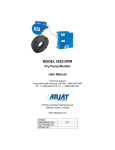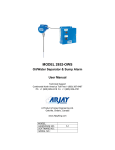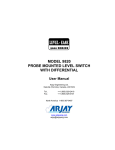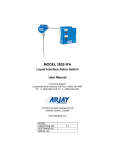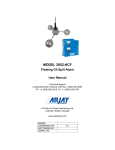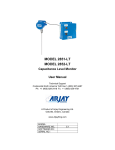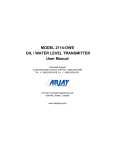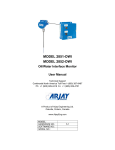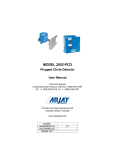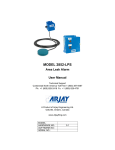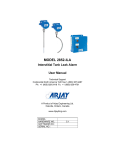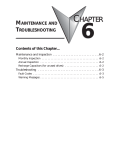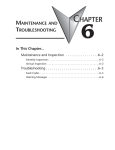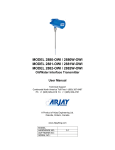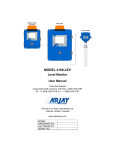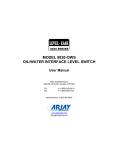Download Manual - Arjay Engineering
Transcript
MODEL 2882-OWS Oil/Water Separator & Sump Alarm User Manual Technical Support Continental North America Toll Free 1-(800) 387-9487 Ph: +1 (905) 829-2418 Fx: +1 (905) 829-4701 A Product of Arjay Engineering Ltd. Oakville, Ontario, Canada www.ArjayEng.com MODEL: HARDWARE NO.: SOFTWARE NO.: SERIAL NO.: 5.0 2882-OWS Oil/Water Separator & Sump Alarm ENGINEERING Reliable monitoring for the oil/water interface in separators Over 40 years of capacitance experience stands behind the 2882-OWS Separator Alarm. The probe is inserted into the separator or sump to the depth of desired oil accumulation. The electronics is calibrated to the capacitance field around the probe. As oil accumulates and displaces the water, the capacitance change around the probe tip is monitored to activate the relays. power input alarms / RS-485 Modbus • no moving parts • electronics are integral to probe • high corrosion resistant Teflon and 316SS parts • HF capacitance does not require routine cleaning • easy calibration and control set-up explosion proof probe head Adjustable time delay and sensitivity adjustment is standard to suppress spurious alarms from intermittent turbulence and wash-down. 3/4” npt 316SS process connection on standard probes (flanges optional) Inactive probe Sheath (length to order) Teflon coated probe (length to order) 2882-OWS Features and Benefits Technical Specifications - Probe • no moving parts • electronics is integral to the probe • high corrosion resistant Teflon and stainless steel wetted parts • capacitance technology responds to all oil types • HF capacitance technology does not require routine cleaning • easy calibration and control set-up Process Temp. Pressure Technical Specifications - Electronics Operating Temp. Resolution Accuracy Power Input Communication Control Interface -20˚C to +55˚C .007% (.07 pF at 1,000 pF) .04% of full scale pF 12 vdc or 24 vdc, 0.1 amp max. 100-240 vac +/- 10% RS-485 Modbus 2 x 10amp@240 vac, SPDT, dry relays plus 4mA Normal / 20 mA alarm output Alarm and Status -60°C to +260°C (Teflon probe) 103 bar/10342 kPA/1500psi at stable temperature ABSA-CRN #OF07450.2 316SS and Teflon CRN Wetted Parts Probe materials are eligible for NACE MR-0175 Compliance Hazardous Location Use Available Component Certifications may be suitable to your application. Consult Arjay for assistance. 2880 Electrical Safety UL, CSA, or IEC 61010 Housing UL / FM / CSA Class 1, Group B,C,D; Class II, Group E,F,G Probe CSA Class 1, Group C,D The electronics for this model can also be mounted remote from the probe. Refer to the Model 2852-OWS. The probe becomes Intrinsically Safe when ordered with an IS Barrier installed in 2852-OWS control panel: CSA Div 1, Class 1, Groups A,B,C,D LCD display of alarm status and menus RS-485 Modbus user interface Relay Outputs 4 mA normal/20 mA alarm output Power input All calibration and power wiring is done at the main control unit. This is mounted directly onto the probe. ENGINEERING Arjay Engineering Ltd. http://www.arjayeng.com 2851 Brighton Road Oakville, Ontario telephone: ++1 905-829-2418 Canada L6H 6C9 N. America toll free: 1-800-387-9487 fax: ++1 905-829-4701 2882-OWS-12a Model: 2882-OWS User Manual TABLE OF CONTENTS 1.0 2.0 3.0 4.0 5.0 6.0 INSTRUMENT OVERVIEW .............................................................................. 3 1.1 Features ................................................................................................ 5 1.2 Model Number vs. Voltage Input ........................................................... 5 1.3 Specifications ........................................................................................ 5 INSTALLATION ................................................................................................. 7 2.1 Controller Installation ............................................................................. 7 2.2 Probe Installation ................................................................................... 7 2.3 Electrical Installation .............................................................................. 8 2.4 Glossary of Symbols ............................................................................. 9 STARTUP AND CALIBRATION ........................................................................ 10 3.1 Startup ................................................................................................... 10 3.2 Menu Flow Chart Background Information ............................................ 10 3.2.1 Menu Description ..................................................................... 10 3.2.2 Menu Flow Chart ...................................................................... 10 3.2.3 Data Entry ................................................................................ 11 3.3 2882 Controller Calibration .................................................................... 11 3.3.1 Site Calibration ......................................................................... 11 SETUP and ALARMS ....................................................................................... 12 4.1 2882 Controller Setup ........................................................................... 12 4.2 2882 Controller Alarms .......................................................................... 13 4.3 2882 Controller Network ........................................................................ 13 4.3.1 Modbus Configuration .............................................................. 13 4.3.2 2800 Series Modbus Register Mapping ................................... 14 TROUBLESHOOTING ...................................................................................... 15 FLOW CHARTS ................................................................................................ 16 TABLE OF FIGURES Figure 1 – Typical 2882-OWS Oil / Water Separator Application .................................. 3 Figure 2 – Typical 2882-OWS Sump Application ........................................................... 4 Figure 3 – Probe Installation .......................................................................................... 7 Figure 4 – Electronics PCB Overview ............................................................................ 8 2 Rev: 1.1 Model: 2882-OWS 1.0 User Manual Rev: 1.1 INSTRUMENT OVERVIEW The Arjay Oil/Water Separator & Sump Alarm provides a means for detecting the accumulation of oil in oil/water separators, sumps, or similar vessels. The Arjay probe has an active capacitance sensor at the probe tip that monitors the water at the depth of the active probe end. Water has a high dielectric constant, which results in a high capacitance reading. Oil (or a similar hydrocarbon or low dielectric liquid) separates to the surface of the water and eventually accumulates to a depth that the oil/water interface crosses the active probe tip. The dielectric of the oil is substantially lower than water, which results in a dramatic decrease in capacitance. The Probe mounted Arjay 2882 controller monitors the capacitance change of the probe and activates a relay contact for use with alarms, pumps, valves, etc. The sensor requires at least 6 mm of oil to cross the active probe to indicate an alarm. Emulsified separations may require more coverage of the probe tip to initiate an alarm. The active probe tip is made to 100mm to accommodate for these emulsified interfaces. The complete 2882-OWS system consists of the probe and the 2882 controller. The standard probe is constructed of a Teflon coated probe with SS inactive sheath. The Oil/Water Separator must be of the type that is permanently filled with water. The clean water is gradually displaced from the vessel as oily water is introduced. The active sensing tip of the probe is positioned below the oil suction pipe and above the clean water discharge pipe. When the oil/water interface reaches the probe tip, the alarm activates. Sumps normally have a pump with the suction on the pit bottom. The liquid level of the sump is maintained above the probe tip with a separate level device so that the probe tip is continuously in liquid. If there is sufficient accumulation of oil that it risks suction by the pump, the alarm activates. A dry probe tip condition in either application will indicate an alarm. Figure 1 – Typical 2882-OWS Oil / Water Separator Application 3 Model: 2882-OWS User Manual Figure 2 – Typical 2882-OWS Sump Application 4 Rev: 1.1 Model: 2882-OWS 1.1 Rev: 1.1 Features 1.2 Microprocessor based capacitance Controller Relay and 4/20mA alarm output Modbus protocol via RS-485 for access by Arjay handheld, Central Access Panel or compatible system Local Auto calibration or remote calibration via network User specified custom features may be added by contacting Arjay Engineering Ltd. Model Number vs. Voltage Input 1.3 User Manual 2882-OWS-1 100-240 VAC power input 2882-OWS-3 12 VAC power input 2882-OWS-4 24 VAC power input Specifications Power Input: 24 VDC or 12 VDC, 250mA maximum 100-240 VAC, 50/60 Hz, 150mA maximum Note: DC input models must be supplied by Limited Energy power source. Limited Energy means compliance with one of the following requirements: Class 2 circuit according to Canadian Electrical Code, Part, I, C22.1; Class 2 circuit according to National Electrical Code, NFPA-70; Limited Power Supply (LPS) according to IEC 60950-1; Limited-energy circuit according to IEC 61010-1. User Interface: Display & Keypad Two line LCD with display of Alarm Condition and menus Select menu or enter values by keypad Communication Interface: RS-485 Modbus Analog /Relay Outputs: mA Signal Output 4 mA during Normal and 20 mA during an alarm condition, 900 Ohms max (24VDC), Relay Output 2 SPDT relay, dry, N.O. Contact 5 A @ 250 VAC (Resistive) and N.C. Contact 3 A @ 250VAC (Resistive), selectable failsafe or non-failsafe, selectable high or low acting alarm, programmable time delay: 0 – 600 seconds **Note: If Isolation is ordered then relays are not available. Instrument Performance: Setpoint Range Submerge active probe tip to desired alarm point 0 - 1000 pF (most applications are 100pF to 500pF) Accuracy 0.2% of setpoint based on clean interface Resolution 0.05% of setpoint via network display 0.002% of Full Scale capacitance via network display Calibration single point Auto calibration 5 User Manual Model: 2882-OWS Environmental: Operating Temperature -20 to +55 °C Controller -60 to +260 °C Probe Relative humidity 0 to 95% (non-condensing) Installation Category II Pollution Degree 2 Mechanical Specification: Refer to dimensional drawing 6 Rev: 1.1 User Manual Model: 2882-OWS 2.0 Rev: 1.1 INSTALLATION NOTE: If any damage to the instrument is found, please notify an Arjay Engineering representative as soon as possible prior to installation. 2.1 Controller Installation Choose the mounting location in accordance with good instrument practice. Extremes of ambient temperature and vibration should be avoided (see specifications and installation drawing). Important Note: The controller operates in a Failsafe mode. This means that the relays are in an energized state during normal operation. The N.O. relay contact will be held closed and the N.C. relay contact will be held open during a normal condition. This will allow the relay to return to it’s non-energized (shelf) state during an alarm, fault or power failure condition. Wire accordingly. 2.2 Probe Installation The probe length is custom ordered to the tank or sump requirements. Determine the probe length so that the alarm point is approximately 50 mm above the probe tip (halfway point on the active probe). The active probe is the exposed 100 mm white Teflon probe. The controller should be mounted above the water surge level and in a protected area. Figure 3 – Probe Installation NOTE: To ensure proper operation and electrical safety, make sure the 2882 enclosure is electrically grounded. 7 User Manual Model: 2882-OWS 2.3 Rev: 1.1 Electrical Installation IMPORTANT: Verify power input ordered. Only apply power type ordered, Figure 4 – Electronics PCB Overview TB1/TB2 - Relay Output 2 SPDT relay, Dry, N.O. Contact 5 A @ 250 VAC (Resistive) and N.C. Contact 3 A @ 250VAC (Resistive), selectable failsafe or non-failsafe, selectable high or low acting alarm, programmable time delay: 0 – 600 seconds TB3 - Power Input Power input as per Model. Check if ordered AC or DC. Earth ground is connected to G. TB4 - Network Output Connect RS485 + and – to the network D+ and D-. TB5 - 4/20 mA Output The 4/20 mA is a sourced output referenced to Ground. It is not loop powered. 4mA = Normal 20mA = Alarm TB6 - Probe Input Probe input is wired by the factory. The terminal block is disconnected during shipment for static reasons and has to be re-connected during installation. TB6 has two “+” connections. Either is acceptable. 8 Model: 2882-OWS 2.4 User Manual Rev: 1.1 Glossary of Symbols Attention, consult accompanying documents Attention, veuillez consulter les documents ci-joints. N Protective Earth Terre de protection Fuse Coupe-circuit; fusible Direct Current (DC) Courant continu Normally open relay contacts Contacts travail Normally closed relay contacts Contacts Repos Power off ArróÕ (mise hors tension) Power on Marche (mise sous tension) L Live Sous tension Neutral Neutre G Ground Terre 9 User Manual Model: 2882-OWS 3.0 STARTUP AND CALIBRATION 3.1 Startup Rev: 1.1 Check the power wiring. Confirm that probe is hooked up to TB6 (Probe Input) as per Figure 4 and is wired in accordance with the electrical installation drawing. Power On the unit. The Status LED on the controller circuit board should be green. A red Status LED indicates a fault condition. If red, check the Troubleshooting section 5.0. The unit is pre-configured and tested at the factory. However, a quick field calibration is required after power up to tune the sensor to the installation and cable conditions. See section 3.3 to calibrate the 2882-OWS . 3.2 Menu Flow Chart Background Information 3.2.1 Menu Description The 2882 has a password protect feature. The default password is 2000. Since the 2882 controller has a compact LCD, some menu descriptions may be in short form. The following are the menu descriptions: Alrm: Alrm Lvl: Alrm Del: ALRM CAL: Cal: Cal Err: Cal Ok: Cal only: Cal Pt: Diags: mA out: Sec: SENSTVTY: ^SP: vSP: Alarm Alarm level Alarm Delay Alarm Calibration Calibration point Calibrate err Calibrate ok Calibrate Only Calibration Point Diagnostics mA output Seconds Sensitivity Relay Setpoint Hi action Relay Setpoint Low action 3.2.2 Menu Flow Chart The 2882 controller will display Normal in its normal operating condition and Alarm during an oil alarm or dry sensor condition. From the main menu, you can select Cal Only, View, and Change. Cal Only allows a calibration based on a factory or custom pre-configuration. In most applications, this is the only menu item required after the initial power-up. The calibration is required at site after power up or anytime a component or sensor is changed out. A password is required to enter this and is described in the calibration section. View allows an operator to view the Calibration setpoint in pF, the Alarms settings such as low or high action, failsafe or non-failsafe and the 0-600 second delay, the Diagnostics of raw readings and the Setup values such as sensitivity and ID address. This can be viewed without a password and without risk of changing any values. This information may be requested during technical assistance inquiries. 10 User Manual Model: 2882-OWS Rev: 1.1 Change is password protected and allows an operator to change the configuration set-up values indicated in the View. Changes could be required for special applications or to re-set the values to the factory default. 3.2.3 Data Entry 3.3 2882 Controller Calibration Power up the 2882 Controller. The status LED should be green. The LCD should go to the standard operating screen as below after a series of the following. It may read Normal or Alarm until a calibration is performed. Arjay S XXXXXX SW X.XXX 2800 Net ID: X HW X.X OWS Normal Operating Screen 3.3.1 Site Calibration A factory pre-configuration and set-up has been defaulted into the 2882-OWS. As such, a user set-up is not required in the field. A basic calibration is only required. As per the Flow Chart, press and hold the Menu key for 5 seconds to enter the main menu. The display will read the first menu item Cal only. Press select key, enter password ¨2000¨. A pF reading of the sensor will be displayed. Press select to acknowledge and then press select to accept the new calibration. To abort, press the <MENU> key. If the calibration is successful, the display will return to the main operating display. To verify the sensor and electronics are responsive, where the installation permits, the probe can be lifted above the water for at least 30 seconds to verify that the control unit alarms. The air simulates an oil condition. The Alarm1 and Alarm2 LEDs on the circuit will activate red. Place the sensor back into the water and the alarm will clear. THIS COMPLETES THE SETUP AND CALIBRATION PROCEDURE FOR THE 2882-OWS Oil/Water Separator and Sump Alarm 11 Model: 2882-OWS 4.0 SETUP AND ALARMS 4.1 2882 Controller Setup User Manual Rev: 1.1 The 2882 controller has the following Setup parameters: 1. Sensitivity The sensitivity determines the amount of pF change required to cause an alarm. The factory default setting is 3.0 pF. Increasing the pF value will increase the amount of oil required to cause an alarm. Since different oils and the conditions of the oil/water separation can affect the pF change, a direct pF to alarm point relationship cannot be factory determined. If this is changed in the field, it should be tested to confirm an alarm. 2. Alarm Calibration above or below setpoint This setting advises the controller if the calibrated pF value is above or below the alarm setpoint. For the OWS, the calibration pF value is above the setpoint because the unit is required to alarm at a lower pF value, which indicates oil. The factory default is Above Setpoint. 3. Defaults Factory settings are pre-configured into the unit based on the most typical set-up required for this application. This provides for a quick and easy calibration at site but can be changed for special applications. If the setup has been changed, selecting default will reset the factory defaults. 4. Net ID The ID number is used only for network applications. To communicate on a network, each controller must have a unique ID number. The factory default ID number is 1. Important: If multiple units on a network have the same address, network errors will result. 5. Filter Data filtering is used to smooth data from a sudden change and minimize fluctuating readings. For example, a 5 second setting means the calculated value of the capacitance and resulting values of pF will start to respond immediately but will take 5 seconds to reach their final values. The factory default is 0 to provide an immediate and active response. This can be user selected from 0 – 99.9 seconds. 12 Model: 2882-OWS 4.2 User Manual Rev: 1.1 2882 Controller Alarms The two relays on the 2882 operate together. The follow parameters are available as a common setting to the two relays: 1. Delay. Minimum time in seconds for an alarm to exist before the relays change to an alarm state. The relay alarm state depends on the Relay Action and Failsafe settings. The factory setting is 20 seconds to suppress false alarms due to sudden of intermittent flows or disturbances in front of the sensor. 2. Action. This determines if the Alarms LEDs should activate when the pF reading rises above or below the setpoint. The factory default is below the setpoint because the application of water to oil is a decrease in capacitance. 3. Failsafe. Failsafe typically means that the relay is held in an energized state when in a normal operating condition as opposed to an alarm condition. In an alarm condition, the relay de-energizes which is identical to when the instrument power is shut off. The rationale is that the alarm condition should match the Power Fail condition. The factory default is Yes for Failsafe. 4.3 2882 Controller Network The 2882-OWS Controller may be monitored and calibrated via RS-485 protocol compatible digital communications. Typical features are: 1. Ease of wiring in multiple level point monitoring: Up to 255 Model 2882's (or other Arjay 2800 Series level monitors) may be connected together in a daisy chain (2 wire communication plus power wiring) connection to an Arjay Remote Access monitor or customer control system which allows viewing data and setup of any of the transmitters on the network. The relay and analog outputs may still be used if necessary. 2. Setup for the 2882 for network operation: Each 2882 transmitter must have a unique ID number to connect in a network system. 4.3.1 Modbus Configuration Parameter settings: 9600 Baud Rate; Even Parity, 8 Data Bits and 1 Stop Bit. Wiring connection: RS485 (+) connect to D+; RS485 (-) connect to D-. 13 User Manual Model: 2882-OWS Rev: 1.1 4.3.2 2800 Series Modbus Register Mapping REG 40001 Zero Based 0 TYPE float No. of Reg 2 40003 2 Hardware Rev / Software Rev byte 1 40004 3 Sensitivity / Mode byte 1 40005 4 Instrument Status int 1 40006 5 Model / Modbus Address byte 1 40007 6 Relay2 Setup / Relay 1 Setup byte 1 40008 7 Password int 1 40009 8 XA "A" cal parameter float 2 40011 10 XK "K" cal parameter float 2 40013 12 XC "C" cal parameter float 2 40015 14 Filter float 2 40017 16 Slope – pF per % level float 2 40019 18 Offset – pF for empty vessel float 2 40021 20 mA output span value float 2 40023 22 mA output Zero value float 2 40025 24 mA output Trim Slope value float 2 40027 26 mA output Trim Offset vlaue float 2 40029 28 Cal1 PV: 1st calibration point level value in % float 2 40031 30 Cal2 PV: 2nd calibration point level value in % float 2 40033 32 Cal1 pF: 1st calibration point capacitance value in pF float 2 40035 34 Cal2 pF: 2nd calibration point capacitance value in pF float 2 40037 36 Relay 1 : Differential High Alarm [% Level]. Only used for Linear Level type. Not used for Single Point Alarm application float 2 40039 38 Relay 2: Differential High Alarm [% Level]. Only used for Linear Level type. Not used for Single Point Alarm application float 2 40041 40 Relay 1: Differential Low Alarm [% Level] OR Single Point Alarm [pF]. Single Point Cal: used as captured pF during cal float 2 40043 42 Relay 2: Differential Low Alarm [%Level]. Only used for Linear Level type. Not used for Single Point Alarm application float 2 40045 44 Relay 1 On delay [in seconds]. Only used for Linear Level or Single Point Alarm application int 1 40046 45 Relay 2 On delay [ in seconds]. Only used for Linear Level type. Not used for Single Point Alarm application int 1 40047 46 mA Analog Output float 2 40049 48 Oscillation Frequency float 2 40051 50 Frequency float 2 40053 52 Capacitance float 2 40055 54 Filtered Capacitance float 2 40057 56 Level float 2 DESCRIPTION Serial Number 14 User Manual Model: 2882-OWS 5.0 Rev: 1.1 TROUBLESHOOTING CONDITION DO THIS 1. Status LED is OFF and the LCD display is off Check the power to the unit. If the unit is a 24/12VDC model, check the external source is 24V/12VDC. Make sure the polarity is correct. If the unit is a 100-240VAC model, then check the Line, Neutral and Ground wiring is correct. 2. If the status LED is RED This indicates a major error such as memory failure, no probe signal etc. Check the following: 3. False Alarms Ensure JP3 jumper is set for internal setting. Make sure probe wire is connected to TB6 on back of electronics (see Fig. 2.1). Microprocessor may have lost its parameters due to a surge in the line. Go to View Menu (see Flow Chart) to check the Calibration values, as well as frequency and capacitance values in Diagnostic Menu. Call Arjay Technical Support. Add some time delay in the unit Make sure there is no external interference and electrical noise such as agitators, high voltage interference, turbulent flow, etc Adjust the sensitivity to the next higher value. Test after any changes to confirm an alarm Make sure the active probe end is in water. ARJAY ENGINEERING TECHNICAL SUPPORT (800) 387-9487 +1 (905) 829-2418 www.arjayeng.com 15 Model: 2882-OWS 6.0 User Manual FLOW CHARTS 16 Rev: 1.1 Model: 2882-OWS User Manual 17 Rev: 1.1 User Manual Model: 2882-OWS Rev: 1.1 CHANGE MENU Sel Mode Change Press <SELECT> Password 0000 Password = 2000 See Note 1 for Entry password Press <SELECT> Press <SELECT> SELECT: Cal Press < > Press < > Press <SELECT> SELECT: Alarms Press < > Press < > Press <SELECT> Cal Pt x.xpF SELECT: Diags Press <SELECT> Cal Pt Confirm Delay xxx > Press < > Press <SELECT> x.xpF x.xHz SENSTVTY 1.0 Press <SELECT> Press <SELECT> See Note 1 Press < > Press < > Press <SELECT> > Press < > ALRM CAL Above SP Press <SELECT> Press <SELECT> > SELECT: Exit Press < > Press < > ALRM CAL See Above SP Note 4 Action See Alrm=vSP Note 2 Press <SELECT> Press <SELECT> Failsafe Yes DEFAULTS Yes? Press <SELECT> Press <SELECT> DEFAULTS Yes? See Note 3 Press <SELECT> Exit > Press < SENSTVTY See Note 1 1.0 Action Alrm=vSP Failsafe Yes Press < Press <SELECT> Press <SELECT> Press < SELECT: Setup Press <SELECT> Delay xxx Press <SELECT> Press < Press <SELECT> Press < > Press < > NET ID 1 Press <SELECT> Press <SELECT> Note 1: Data Entry Press < > / < > key to increase / decrease the digital value. Press <SELECT> key to move the cursor. Note 2: High & Low Selection Press < > / < > key to toggle between v (low) & ν (high) action. Note 3: Yes & No Selection Press < > / < > key to toggle between Yes & No action. Note 4: Above & Below Selection Press < > / < > key to toggle between Above & Below action. 18 See Note 1 NET ID 001 See Note 3 FILTER 0 Press <SELECT> FILTER 00 See Note 1 Press <SELECT> Exit Press <SELECT> Press < > Press < >





















